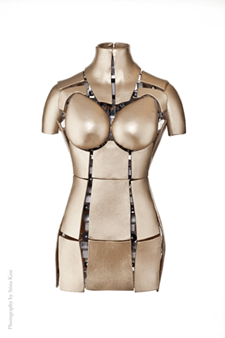 Fits.me aims to increase clothing sales online and reduce returns by showing female shoppers clothing on a mannequin matching her exact dimensions. It does this by using robotic mannequins with artificial muscles that can simulate the shape and size of any body. While a male robot, or Fitbot, has been available for some time, the long-anticipated female version will launch soon at British retailer Hawes & Curtis.
Fits.me aims to increase clothing sales online and reduce returns by showing female shoppers clothing on a mannequin matching her exact dimensions. It does this by using robotic mannequins with artificial muscles that can simulate the shape and size of any body. While a male robot, or Fitbot, has been available for some time, the long-anticipated female version will launch soon at British retailer Hawes & Curtis.
Due to the larger variations in the shape and size of the female body, the female FitBot robot was more complicated to accurately model than the male torso and took longer to perfect. Fitbots are available to match over 85 percent of female shoppers.
Clothing is currently the largest online retail sector, estimated to be worth $26 billion a year in the US alone. Yet only 7 percent of clothing is bought online. The fact that shoppers cannot try on clothing before purchasing results in a very high rate of returned merchandise (over 40 percent for some types of fitted clothing) and associated costs for retailers.
Female clothing tends to be more fitted and more varied than male garments. Based on personal experience, I know that it is very difficult to be sure an item bought online will fit and hang right. Hawes & Curtis has seen sales to new customers increase by 57 percent since the introduction of the male FitBot, and returns are at a record low of 2.99 percent. The impact on female shoppers is likely to be even greater.
 Fits.me works with a German company called Human Solutions, which provides a database of the most common body dimensions taken from 3D imaging of tens of thousands of people. A selection of target shapes are chosen for the robot. Not every item of clothing in every size needs to be physically tried on the robot. Instead, sizing samples are put on the robot for each of the target body shapes, and the result is photographed. On average, you need 4 garments from a brand to establish the sizing. Big brands like Gap will have 10-15 fit samples. Most clothing brands have 4-7.
Fits.me works with a German company called Human Solutions, which provides a database of the most common body dimensions taken from 3D imaging of tens of thousands of people. A selection of target shapes are chosen for the robot. Not every item of clothing in every size needs to be physically tried on the robot. Instead, sizing samples are put on the robot for each of the target body shapes, and the result is photographed. On average, you need 4 garments from a brand to establish the sizing. Big brands like Gap will have 10-15 fit samples. Most clothing brands have 4-7.
When a shopper wants to see a size on her own body shape, mathematical algorithms are used to manipulate the most similar image of the robot. This is combined with information about the physical properties of the garment and how it takes on shape (some materials are more clingy or stretchy than others) to show the shopper a simulation of the garment on her own body shape.
Fits.me doesn’t seem to have any direct competitors, although there are plenty of companies that provide styling or sizing advice and virtual dressing rooms of various types. Based in Estonia, Fits.me launched in May 2009 and has raised a total of 2.3 million EUR ($3.32 million) from the Estonian development fund and private investors.
VentureBeat's mission is to be a digital town square for technical decision-makers to gain knowledge about transformative enterprise technology and transact. Learn More

